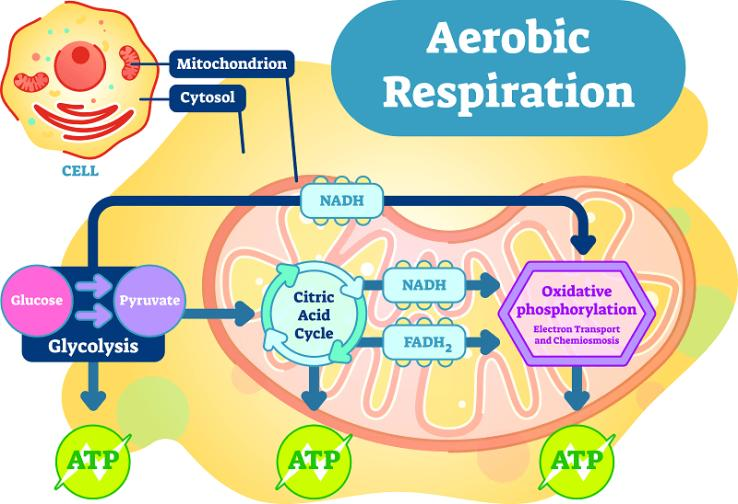
What stage of aerobic respiration requires ATP?
Answer
411.3k+ views
Hint: Aerobic respiration takes place in cells in the presence of oxygen to produce energy from food. It is common in most of the plants, animals and other mammals. Carbon dioxide and water are produced as end products with the formation of ATP in this respiration. The four stages of aerobic respiration are glycolysis, formation of acetyl coenzyme A, citric acid cycle and oxidative phosphorylation.
Complete explanation:
The first half of glycolysis in aerobic respiration needs ATP molecules. Glycolysis, also known as the EMP, takes place in the cytosol of the cells. Glycolysis can be divided into two phases- preparatory phase and payoff phase. Here one molecule of glucose is converted into two molecules of pyruvate along with generation of two net molecules of ATP. For one glucose molecule, four ATP molecules are actually produced but two are consumed as part of the preparatory phase of glycolysis.
Preparatory phase is also known as the glucose activation phase. It starts with the phosphorylation of glucose. At the end of this phase, the hexose chain is cleaved into two triose phosphates with the help of two ATP molecules.
Payoff phase is also known as the energy extraction phase. The end reaction of this phase is the conversion of glyceraldehyde-

Note:
The acetyl coA enters the citric acid cycle and gets converted into oxaloacetate. This molecule undergoes a series of events to produce three molecules of NADH, one molecule of
Complete explanation:
The first half of glycolysis in aerobic respiration needs ATP molecules. Glycolysis, also known as the EMP, takes place in the cytosol of the cells. Glycolysis can be divided into two phases- preparatory phase and payoff phase. Here one molecule of glucose is converted into two molecules of pyruvate along with generation of two net molecules of ATP. For one glucose molecule, four ATP molecules are actually produced but two are consumed as part of the preparatory phase of glycolysis.
Preparatory phase is also known as the glucose activation phase. It starts with the phosphorylation of glucose. At the end of this phase, the hexose chain is cleaved into two triose phosphates with the help of two ATP molecules.
Payoff phase is also known as the energy extraction phase. The end reaction of this phase is the conversion of glyceraldehyde-

Note:
The acetyl coA enters the citric acid cycle and gets converted into oxaloacetate. This molecule undergoes a series of events to produce three molecules of NADH, one molecule of
Latest Vedantu courses for you
Grade 9 | CBSE | SCHOOL | English
Vedantu 9 CBSE Pro Course - (2025-26)
School Full course for CBSE students
₹35,000 per year
Recently Updated Pages
Express the following as a fraction and simplify a class 7 maths CBSE

The length and width of a rectangle are in ratio of class 7 maths CBSE

The ratio of the income to the expenditure of a family class 7 maths CBSE

How do you write 025 million in scientific notatio class 7 maths CBSE

How do you convert 295 meters per second to kilometers class 7 maths CBSE

Write the following in Roman numerals 25819 class 7 maths CBSE

Trending doubts
State and prove Bernoullis theorem class 11 physics CBSE

What are Quantum numbers Explain the quantum number class 11 chemistry CBSE

Write the differences between monocot plants and dicot class 11 biology CBSE

1 ton equals to A 100 kg B 1000 kg C 10 kg D 10000 class 11 physics CBSE

State the laws of reflection of light

In northern hemisphere 21st March is called as A Vernal class 11 social science CBSE




